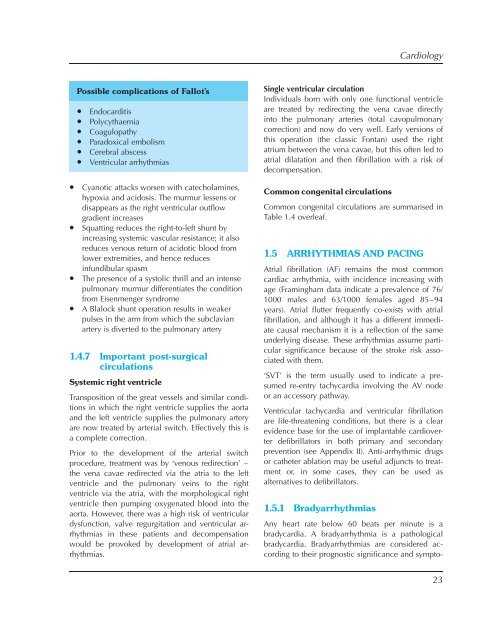Essential Revision Notes for MRCP Third Edition - PasTest
Essential Revision Notes for MRCP Third Edition - PasTest
Essential Revision Notes for MRCP Third Edition - PasTest
- No tags were found...
Create successful ePaper yourself
Turn your PDF publications into a flip-book with our unique Google optimized e-Paper software.
CardiologyPossible complications of Fallot’s• Endocarditis• Polycythaemia• Coagulopathy• Paradoxical embolism• Cerebral abscess• Ventricular arrhythmias• Cyanotic attacks worsen with catecholamines,hypoxia and acidosis. The murmur lessens ordisappears as the right ventricular outflowgradient increases• Squatting reduces the right-to-left shunt byincreasing systemic vascular resistance; it alsoreduces venous return of acidotic blood fromlower extremities, and hence reducesinfundibular spasm• The presence of a systolic thrill and an intensepulmonary murmur differentiates the conditionfrom Eisenmenger syndrome• A Blalock shunt operation results in weakerpulses in the arm from which the subclavianartery is diverted to the pulmonary artery1.4.7 Important post-surgicalcirculationsSystemic right ventricleTransposition of the great vessels and similar conditionsin which the right ventricle supplies the aortaand the left ventricle supplies the pulmonary arteryare now treated by arterial switch. Effectively this isa complete correction.Prior to the development of the arterial switchprocedure, treatment was by ‘venous redirection’ –the vena cavae redirected via the atria to the leftventricle and the pulmonary veins to the rightventricle via the atria, with the morphological rightventricle then pumping oxygenated blood into theaorta. However, there was a high risk of ventriculardysfunction, valve regurgitation and ventricular arrhythmiasin these patients and decompensationwould be provoked by development of atrial arrhythmias.Single ventricular circulationIndividuals born with only one functional ventricleare treated by redirecting the vena cavae directlyinto the pulmonary arteries (total cavopulmonarycorrection) and now do very well. Early versions ofthis operation (the classic Fontan) used the rightatrium between the vena cavae, but this often led toatrial dilatation and then fibrillation with a risk ofdecompensation.Common congenital circulationsCommon congenital circulations are summarised inTable 1.4 overleaf.1.5 ARRHYTHMIAS AND PACINGAtrial fibrillation (AF) remains the most commoncardiac arrhythmia, with incidence increasing withage (Framingham data indicate a prevalence of 76/1000 males and 63/1000 females aged 85–94years). Atrial flutter frequently co-exists with atrialfibrillation, and although it has a different immediatecausal mechanism it is a reflection of the sameunderlying disease. These arrhythmias assume particularsignificance because of the stroke risk associatedwith them.‘SVT’ is the term usually used to indicate a presumedre-entry tachycardia involving the AV nodeor an accessory pathway.Ventricular tachycardia and ventricular fibrillationare life-threatening conditions, but there is a clearevidence base <strong>for</strong> the use of implantable cardioverterdefibrillators in both primary and secondaryprevention (see Appendix II). Anti-arrhythmic drugsor catheter ablation may be useful adjuncts to treatmentor, in some cases, they can be used asalternatives to defibrillators.1.5.1 BradyarrhythmiasAny heart rate below 60 beats per minute is abradycardia. A bradyarrhythmia is a pathologicalbradycardia. Bradyarrhythmias are considered accordingto their prognostic significance and sympto-23
















